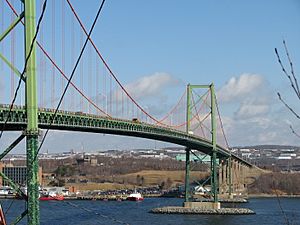A. Murray MacKay Bridge facts for kids
Quick facts for kids A. Murray MacKay Bridge |
|
|---|---|

The MacKay Bridge as seen from Halifax
|
|
| Coordinates | 44°40′40″N 63°36′43″W / 44.6778°N 63.6119°W |
| Carries | Four lanes of |
| Crosses | Halifax Harbour |
| Locale | Halifax Regional Municipality (Halifax – Dartmouth) |
| Official name | A. Murray MacKay Bridge |
| Other name(s) | MacKay Bridge, the New Bridge |
| Maintained by | Halifax-Dartmouth Bridge Commission |
| MMSI | 16141 |
| Characteristics | |
| Design | Suspension bridge |
| Total length | 1,200 metres (3,937 ft) |
| Width | 4 lanes |
| Height | 96 metres (315 ft) |
| Longest span | 426 metres (1,398 ft) |
| Clearance above | 55.2 metres (181.1 ft) at centre-span |
| Clearance below | 46.9 metres (153.9 ft) at centre-span |
| History | |
| Construction begin | 1966 |
| Opened | July 10, 1970 |
| Statistics | |
| Daily traffic | 66,000 (2012) |
| Toll | $1.00 CAD cash / $0.80 MACPASS |
The A. Murray MacKay Bridge is a suspension bridge in Nova Scotia, Canada. People often call it "the new bridge." It connects the Halifax Peninsula with Dartmouth. The bridge opened on July 10, 1970.
It is one of two suspension bridges that cross Halifax Harbour. The other one is the Angus L. Macdonald Bridge, which was finished in 1955. The MacKay Bridge is a busy road, carrying about 52,000 vehicles every day. It is part of Nova Scotia Highway 111.
To cross the bridge, drivers pay a small fee called a toll. For regular cars, it costs $1.00 if you pay with cash. If you use an electronic system called Macpass, it costs 80¢. Bigger vehicles like semi-trailers pay more, depending on how many axles they have. The A. Murray MacKay Bridge is the only harbour bridge that allows large trucks. People walking or riding bicycles are not allowed on this bridge. They can use the Angus L. Macdonald Bridge instead, which has special lanes for them.
Building the Bridge
When Was It Built?
Work on the A. Murray MacKay Bridge started in 1966. It took four years to build. The bridge officially opened to traffic on July 10, 1970.
How Was It Paid For?
Building a big bridge costs a lot of money. The people in charge decided to borrow money from other countries. They chose loans with low interest rates. This helped keep the tolls (the fees to cross the bridge) low at first.
However, over time, the value of the Canadian dollar changed. It became worth less compared to the money from other countries where the loans came from. This made the loans much more expensive to pay back. The amount of money owed grew a lot. Even so, the bridge continued to serve the community.
Bridge Design
The A. Murray MacKay Bridge is about 1,200 meters (nearly 4,000 feet) long. The part that hangs over the water is about 740 meters (2,400 feet) long. It has four lanes for cars and trucks. The speed limit on the bridge is 70 kilometers per hour (about 43 miles per hour).
This bridge was special because of how it was built. It was the first bridge in North America to use a special type of steel deck. This design made the bridge much lighter than older bridges, like the nearby Macdonald Bridge. Engineers also used wind tunnel tests when designing it. This helped them understand how strong winds would affect the bridge during construction and after it was finished.

